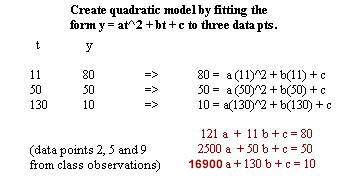"
Precalculus I Class Notes 8/27/98
Quadratic Model of Depth vs. Clock
Time (3 points, 3 simultaneous equations)
Here we
- quickly review the properties of a quadratic
function,
- go through the details of creating a quadratic model
from a set of data and
- compare the model with our data.
The graph of y = x^2 is a parabola symmetric with
respect to the x axis and with its vertex at the origin (0,0).
We can obtain a graph which very closely models our
depth vs. time data (see previous class notes) if we shift this parabola to the right and
stretch it in the horizontal (right-left) direction, so it reaches its low point around t
= 180 seconds, and in the vertical (up-down) direction so it passes through the y axis
around y = 100.
Any parabola can be obtained in this way, and every
parabola whose axis of symmetry is vertical will be represented by some quadratic function
y = a t^2 + b t + c. Furthermore every quadratic function will have a parabola as
its graph.

Video file #09
http://youtu.be/hz9G6cRVGNc
To create a quadratic model we can choose three
DATA points.
- We have somewhat arbitrarily chosen (11,80), (50,50)
and (130,10) from the nine data points obtained previously.
- We will then substitute these data points into the
form y = a t^2 + b t + c of a quadratic function of time.
From the point (11,80), we see that when we
substitute 11 for t and 80 for y we obtain the equation 80 = a (11)^2 + b(11) + c.
- The other points give us, in the same way, the
equations we see below.
- These equations can be simplified into the 'red' set
of three simultaneous linear equations (i.e., 121 a + 11 b + c = 80, etc.).

Video file #10
http://youtu.be/HQF_9FkLG2U
We can solve such a system by any of several
methods. Here we use elimination.
- We see that by subtracting the first equation from
the second (the 'purple' set of calculations) we obtain the equation 2379 a + 39 b = -30,
and
- by subtracting the second from the third the
equation 14400 a + 80 b = -40.
- We now have a system of two equations in the two
unknowns a and b.
This system of two equations is reduced in the
'green' set of calculations.
- We choose to eliminate b.
- To do so we multiply the first equation by 80 and
the second by -39, so that the coefficients of b are equal and opposite.
- Then the sum of the two equations give us a single
equation, with b eliminated and only a remaining as a parameter.
We solve the resulting equation for a (the 'red'
calculations).

Video file #11
http://youtu.be/EeA_JUGGeEw
Video file #12
http://youtu.be/yuuthNT7wOA
Having obtained a we proceed to obtain the values
of b and c by 'back-substitution':
- Substituting a = .00226 into the equation 2379a +
39b = -30 we obtain an equation which we easily solve for b (green arrows and
calculations).
- Then we substitute our values of a and b into the
first of the original equations to get c (purple arrow and calculations).
We substitute the values we have obtained for a and
b back into the form y = a t^2 + b t + c:
- We end up with the model y = a t^2 + bt + c = .00226
t^2 - .907 t + 89.7.

Video file #13
http://youtu.be/bGMxqJl6SXw
We now evaluate the model to determine how well it
fits our original data set:
- We evaluate the model at the observed t values
(excepting the ones we chose, which the model will automatically fit perfectly).
- We obtain excellent, but not perfect, agreement with
our data.
- The steadily increasing pattern to our residuals
suggests that by 'tilting' the parabola slightly we could improve the fit.

Video file #14
http://youtu.be/o1BIH1wSrU8
"
